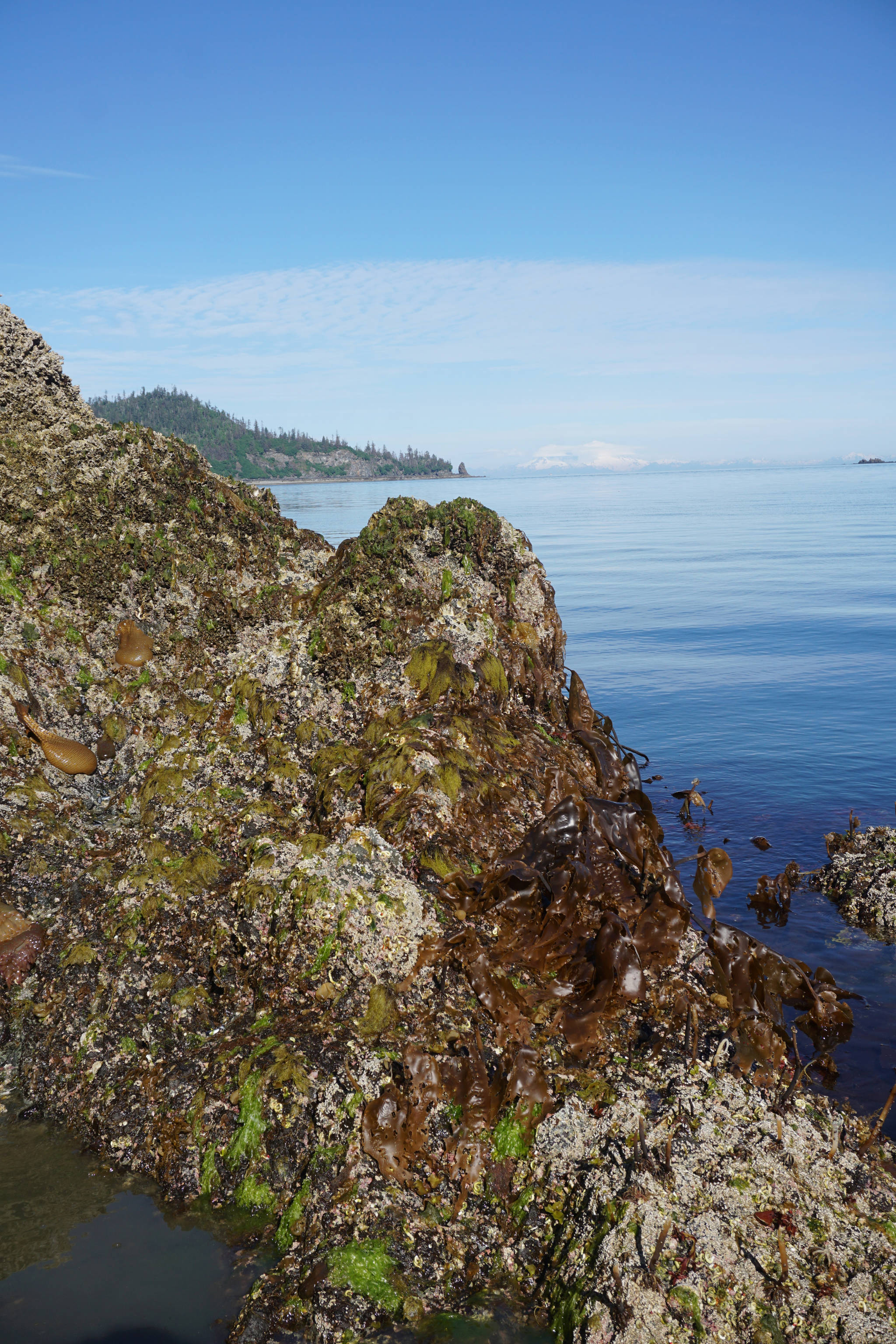What happens rarely, features lots of red-and-green things and brings gifts? Nope — it’s not Christmas, but the big summer low tides. Since late April, a string of minus 4 foot tides have sucked the sea out, exposing rocks and tidepools and revealing sea stars, nudibranches, chitons, anemones and marine invertebrates. Naturalists put on their rubber boots, get out their identification charts and slosh out to sea.
Tidepooling can be done at average tides. At the Center for Alaskan Coastal Studies Peterson Bay Field Station, naturalists lead tidepool tours all summer “regardless of what the tide is,” said Caitlin Marsteller, field station coordinator and tour guide. Marsteller is a graduate student working on her master of science degree at Alaska Pacific University, Anchorage, and studying the Pacific giant octopus.
As she puts it, “I get paid to treasure hunt every day.”
“The ranges go from the splash zone to the high tide zone to low,” she said. “When it gets down to the negative 5 feet, that’s when we get excited.”
Last month, a big minus 5.9 tide exposed creatures like opalescent nudibranches, translucent white with waving orange fringes. They prey on anemones, eating their stingers and incorporating them into their cells, Marsteller said.
Big minus tides also reveal the Christmas anemones, red and green blobs that flop down at an extreme tide. Chitons, the weird creatures that look like upside down boats, cling to rocks.
Most common are katy or black leather chitons, but also can be seen are gumboot and striped chitons. The celebrities of the low-tide zone are the sea stars.
In years past, sea stars — incorrectly called star fish — of all varieties would be common, but over the past few years an epidemic called sea star wasting disease has devastated the Pacific Northwest population including Kachemak Bay.
“It kind of wiped out most of our sea star species,” Marsteller said. “We used to find 100s of sea stars in the intertidal zone.”
Particularly hard hit have been the sunflower stars, the giant, 1-foot or bigger, many rayed sea stars. More resilient have been the leather or bat stars with big rays. At the China Poot Bay beach where tours visit from Peterson Bay, Marsteller said they’ve begun to see small, juvenile sea stars, including six-ray stars, blood stars and sunflower stars.
“The idea is hopefully if we see those juveniles settle out and they stay healthy and don’t show signs of the disease, they’ll withstand it,” Marsteller said.
Tidepooling tours range from the Peterson Bay tour, $155 for adults, that includes a boat trip, to the free tours offered on good low tides at Bishop’s Beach by staff from the Alaska Maritime National Wildlife Refuge. CACS also offers Creature of the Dock tours at the harbor at $7 a person, a guided tour that shows tidepool creatures clinging to harbor floats and pilings.
Animals exposed at extreme low tides will survive exposure. Practice good tidepooling etiquette to give them a chance. Marsteller said CACS’s mission is to connect people with nature.
“We want people to interact with nature, hold them, but with least impact,” she said. “I just think of it the same way as when we go hiking with ‘leave no trace rules.’ Don’t take anything back from the beach that is living or can’t be harvested.”
She has these recommendations:
• It’s OK to turn over rocks, but don’t flip rocks bigger than your head to keep from crushing critters when you put the rock back.
• If you turn a rock over, put it back the way you found it.
• Be gentle. Use the two-finger rule. If you can’t pull an animal off a rock with just two fingers, leave it.
• Watch where you walk, especially for big Christmas anemones.
• Stay low when picking something up so if it slips from your hands it won’t be injured.
• Don’t harass animals like octopus.
The Homer coast from the Spit to Bishop’s Beach offers the most accessible tidepooling. Guided tours help people identify interesting creatures, but people can strike out on their own with help from a laminated species guide by Carmen and Conrad Field sold at local stores. With the popularity of tidepooling in Homer, you also could get lucky and meet a local citizen scientist.
The late Carmen Field taught hundreds of locals about marine invertebrates in her Kachemak Bay Campus classes. Her legacy can be found in her students, and on a good tide, if you see people poking around rocks who look like they know what they’re doing, odds are they took Field’s class.


